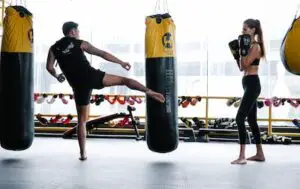Taekwondo is a martial art that originated from South Korea. It focuses on self-defense techniques and striking movements such as punches, kicks, and blocks. In addition to physical strength, Taekwondo practitioners also need to have a good understanding of pressure points. These are specific areas on the body where applying force can cause pain, immobilization, or unconsciousness. In this article, we will discuss what Taekwondo pressure points are, their different types, and how they are used in self-defense.
What are Taekwondo pressure points?
Pressure points are areas on the body where the nerves and blood vessels are close to the surface. When these areas are struck or pressed, they can cause pain, paralysis, or even unconsciousness. Pressure points exist throughout the body, but some are more vulnerable to attack than others. In Taekwondo, pressure points are used to weaken the opponent, create openings for attacks, or prevent attacks from being executed.
What are the different types of Taekwondo pressure points?
There are two main types of pressure points in Taekwondo: vital points and non-vital points.
Vital points are areas on the body where a strike can cause serious injury or even death. These points are usually located on the head, neck, throat, chest, and groin. In Taekwondo, vital points are used as a last resort since they can cause permanent damage to the opponent.
Non-vital points are areas on the body where a strike can cause pain, discomfort, or temporary immobilization. These points are located on the arms, legs, back, and torso. In Taekwondo, non-vital points are used to distract the opponent, create openings for attacks, or disable their movements.
What are some examples of Taekwondo pressure points?
1. Chengfu point – The Chengfu point is located on the chest, between the nipples. A strike to this point can cause pain, dizziness, and difficulty breathing.
2. Gallbladder 20 point – The Gallbladder 20 point is located at the base of the skull, on either side of the spine. A strike to this point can cause dizziness, nausea, and disorientation.
3. Lung 1 point – The Lung 1 point is located on the chest, just below the collarbone. A strike to this point can cause pain and difficulty breathing.
4. Liver 14 point – The Liver 14 point is located on the lower abdomen, just below the ribs. A strike to this point can cause pain and temporary paralysis.
5. Bladder 10 point – The Bladder 10 point is located on the back of the neck, just below the base of the skull. A strike to this point can cause dizziness, headache, and nausea.
6. Stomach 9 point – The Stomach 9 point is located on the throat, just below the Adam’s apple. A strike to this point can cause pain, gagging, and difficulty breathing.
How are Taekwondo pressure points used in self-defense?
In self-defense situations, Taekwondo practitioners use pressure points to gain an advantage over their opponent. By striking or pressing on these points, they can create openings for attacks, disable their opponent’s movements, or incapacitate them temporarily. However, it’s important to remember that pressure points should only be used as a last resort and with the utmost caution.
Here are some ways that Taekwondo pressure points can be used in self-defense:
1. To weaken the opponent – By striking non-vital points such as the arms and legs, Taekwondo practitioners can weaken their opponent’s movements and reduce their ability to attack.
2. To create openings for attacks – By striking vital points such as the groin or the eyes, Taekwondo practitioners can create openings for attacks to other parts of the body.
3. To prevent attacks from being executed – By striking pressure points such as the Chengfu point, Taekwondo practitioners can cause pain and discomfort that can prevent their opponent from executing an attack.
4. To defend against multiple attackers – By striking pressure points that can incapacitate multiple attackers at once, Taekwondo practitioners can increase their chances of survival in a self-defense situation.
5. To escape from grabs and holds – By striking pressure points such as the Gallbladder 20 point, Taekwondo practitioners can create enough discomfort to allow them to escape from grabs and holds.
6. To defend against weapons – By striking pressure points that can temporarily immobilize the opponent, Taekwondo practitioners can defend themselves against weapons such as knives or batons.
Conclusion
Pressure points are an important part of Taekwondo self-defense techniques. While they can be effective in weakening and disabling opponents, they should only be used as a last resort and with caution. Taekwondo practitioners should have a good understanding of the different types of pressure points and how to use them effectively in self-defense situations. By mastering pressure points, Taekwondo practitioners can increase their chances of survival and protect themselves and their loved ones in dangerous situations.





